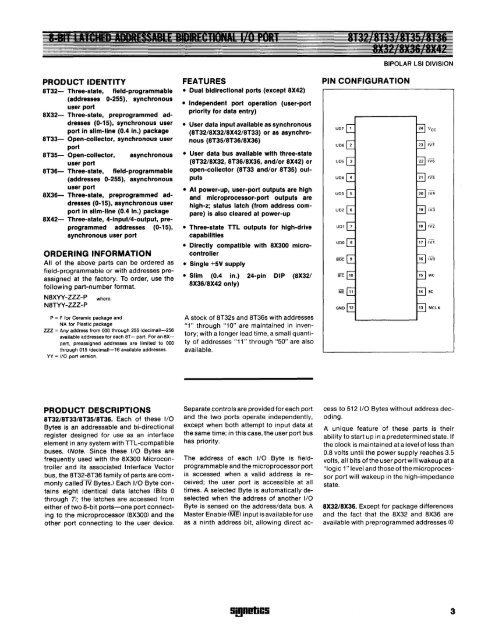8x300 design guide - Al Kossow's Bitsavers - Trailing-Edge
8x300 design guide - Al Kossow's Bitsavers - Trailing-Edge
8x300 design guide - Al Kossow's Bitsavers - Trailing-Edge
You also want an ePaper? Increase the reach of your titles
YUMPU automatically turns print PDFs into web optimized ePapers that Google loves.
PRODUCT IDENTITY<br />
aT32- Three-state, field-programmable<br />
(addresses 0-255), synchronous<br />
user port<br />
aX32- Three-state, preprogrammed addresses<br />
(0-15), synchronous user<br />
port in slim-line (0.4 in.) package<br />
aT33- Open-collector, synchronous user<br />
port<br />
aT35- Open-collector, asynchronous<br />
user port<br />
aT36- Three-state, field-programmable<br />
(addresses 0-255), asynchronous<br />
user port<br />
aX36- Three-state, preprogrammed addresses<br />
(0-15), asynchronous user<br />
port In slim-line (0.4 in.) package<br />
aX42- Three-state, 4-inputl4-output, preprogrammed<br />
addresses (0-15),<br />
synchronous user port<br />
ORDERING INFORMATION<br />
<strong>Al</strong>l of the above parts can be ordered as<br />
field-programmable or with addresses preassigned<br />
at the factory. To order, use the<br />
following part-number format.<br />
N8XYY-ZZZ-P<br />
N8TYY-ZZZ-P<br />
where,<br />
P = F for Ceramic package and<br />
NA for Plastic package<br />
ZZZ = Any address from 000 through 255 (decimalJ-256<br />
available addresses·for each 8T-- part. For an ax-<br />
part, preassigned addresses are limited to 000<br />
through 015 (decimalJ-16 available addresses.<br />
YY = 1/0 port version.<br />
FEATURES<br />
• Dual bidirectional ports (except SX42)<br />
• Independent port operation (user-port<br />
priority for data entry)<br />
• User data input available as synchronous<br />
(ST32/aX32/aX42/aT33) or as asynchronous<br />
(aT35/aT36/aX36)<br />
• User data bus available with three-state<br />
(aT32/aX32, aT36/aX36, and/or aX42) or<br />
open-collector (aT33 and/or aT35) outputs<br />
• At power-up, user-port outputs are high<br />
and microprocessor-port outputs are<br />
high-z; status latch (from address compare)<br />
is also cleared at power-up<br />
• Three-state TTL outputs for high-drive<br />
capabilities<br />
• Directly compatible with aX300 microcontroller<br />
• Single +5V supply<br />
• Slim (0.4 in.) 24-pin DIP (aX32/<br />
aX36/aX42 only)<br />
A stock of 8T32s and 8T36s with addresses<br />
"1" through "10" are maintained in inventory;<br />
with a longer lead time, a small quantity<br />
of addresses "11" through "50" are also<br />
available.<br />
113211133!113S/1136<br />
111211136,'1142<br />
PIN CONFIGURATION<br />
BIPOLAR LSI DIVISION<br />
UD7 1 24 VCC<br />
UD6 2 23 IV7<br />
UD5 3 22 IV6<br />
UD4 4 21 IV5<br />
UD3 5 20 IV4<br />
UD2 6 19 IV3<br />
UD1 7 18 IV2<br />
UDO 8 17 IV1<br />
BOC 9 16 IVO<br />
BIC 10 15 WC<br />
ME 11 14 SC<br />
GND 12 13 MCLK<br />
PRODUCT DESCRIPTIONS<br />
aT32JST33/ST35/ST36. Each of these I/O<br />
Bytes is an addressable and bi-directional<br />
register <strong>design</strong>ed for use as an interface<br />
element in any system with TTL-compatible<br />
buses. (Note. Since these I/O Bytes are<br />
frequently used with the 8X300 Microcontroller<br />
and its associated Interface Vector<br />
bus, the 8T32-8T36 family of parts are commonly<br />
callecfW Bytes') Each I/O Byte contains<br />
eight identical data latches (Bits 0<br />
through 7); the latches are accessed from<br />
either of two 8-bit ports-one port connecting<br />
to the microprocessor (8X30Q) and the<br />
other port connecting to the user device.<br />
Separate controls are provided for each port<br />
and the two ports operate independently,<br />
except when both attempt to input data at<br />
the same time; in this case, the user port bus<br />
has priority.<br />
The address of each 110 Byte is fieldprogrammable<br />
and the microprocessor port<br />
is accessed when a valid address is received;<br />
the user port is accessible at all<br />
times. A. selected Byte is automatically deselected<br />
when the address of another I/O<br />
Byte is sensed on the address/data bus. A<br />
Master Enable (ME) input is available for use<br />
as a ninth address bit, allowing direct ae-<br />
cess to 512 I/O Bytes without address decoding.<br />
A unique feature of these parts is their<br />
ability to start up in a predetermined state. If<br />
the clock is maintained at a level of less than<br />
0.8 volts until the power supply reaches 3.5<br />
volts, all bits of the user port will wakeup at a<br />
"logic 1" level and those of the microprocessor<br />
port will wakeup in the high-impedance<br />
state.<br />
aX32/aX36. Except for package differences<br />
and the fact that the 8X32 and 8X36 are<br />
available with preprogrammed addresses (0<br />
!ijgIOliC!i<br />
3

















